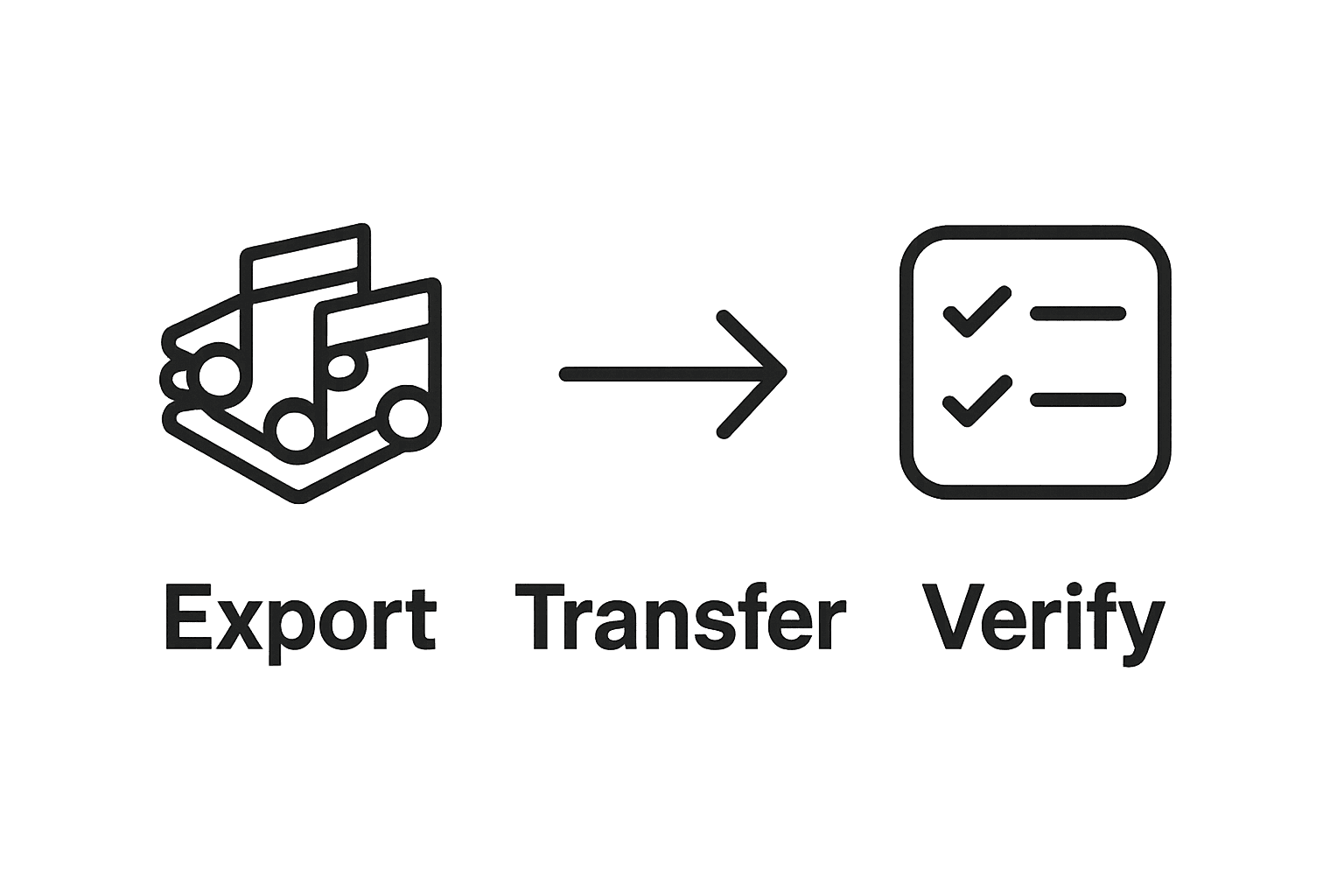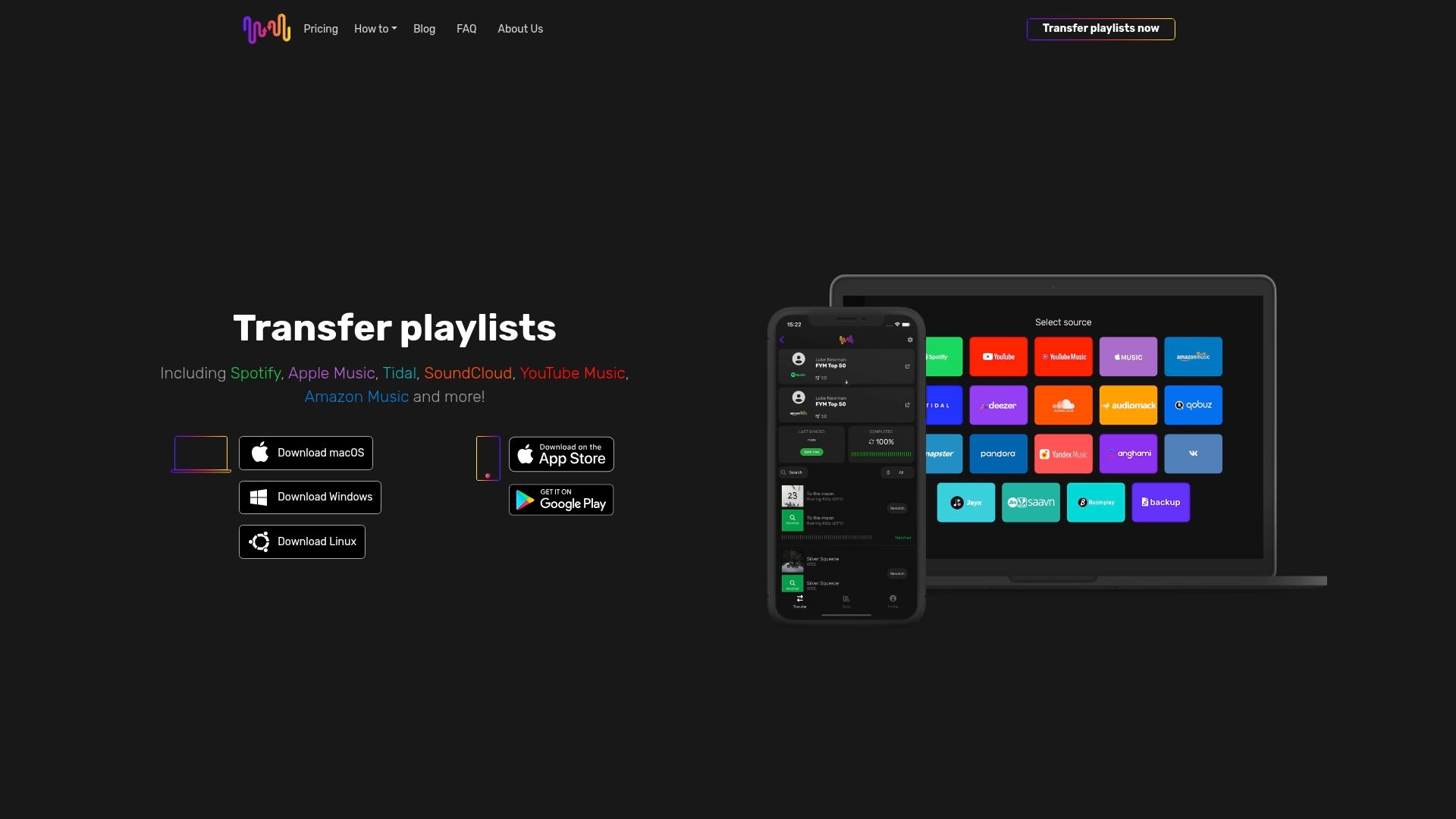Switching music streaming services might sound intimidating, especially if your collection has been building for years. Over 80 million Americans use more than one streaming service every month, yet most never move their actual playlists or favorite tracks to a new platform. The surprising part is that moving your whole music library doesn’t have to mean starting from scratch at all.
Quick Summary
| Key Point | Explanation |
|---|---|
| 1. Assess your music library's format | Conduct a detailed inventory of playlists, tracks, and metadata for an effective migration strategy. |
| 2. Research streaming platform compatibility | Compare service features and technical capabilities to ensure smooth transfer of your music. |
| 3. Prepare playlists for export | Clean and organize your playlists to prevent issues during the migration process. |
| 4. Choose a reliable music transfer tool | Select tools that automate the migration and preserve metadata to simplify the transition. |
| 5. Verify successful transfer integrity | Conduct a thorough audit post-transfer to confirm all tracks, structures, and metadata are intact. |
Step 1: Assess Your Current Music Library's Format
Music collection transfer begins with a comprehensive understanding of your current library's structure and composition. This initial assessment serves as the critical foundation for a smooth migration process, helping you anticipate potential challenges and prepare strategic approaches for transferring your musical inventory.
Understanding Your Library's Composition
Start by conducting a thorough inventory of your music collection across different platforms and devices. Gather information about the total number of playlists, individual tracks, albums, and any specialized collections you've curated over time. Pay special attention to the source platforms where your music currently resides, such as Spotify, Apple Music, YouTube Music, or local storage systems.
Take time to examine the metadata associated with your music files. This includes tracking details like song titles, artist names, album information, and any custom tags or categorizations you might have created. Metadata plays a crucial role in ensuring accurate transfers and maintaining the integrity of your music library during migration.
Assessing Platform Compatibility
Evaluate the compatibility of your current music formats with potential destination platforms. Different streaming services support varying audio qualities, file types, and metadata structures. Some platforms might have limitations on playlist lengths or specific genre categorizations. Check out our guide on playlist transfer compatibility to understand potential translation challenges between services.
For users with extensive or complex music libraries, consider creating a preliminary spreadsheet or document that catalogs your collection's key characteristics. Document the total number of tracks, playlist structures, and any unique organizational systems you've developed. This preparatory step will help you identify potential transfer obstacles and develop targeted migration strategies.
A successful library assessment involves more than just counting tracks. You'll want to note any specialized playlists like workout mixes, mood-based collections, or genre-specific compilations that might require extra attention during transfer. By understanding your library's nuanced structure, you'll be better equipped to preserve its original organization and personal significance throughout the migration process.
Verify your assessment by confirming you have a clear understanding of:
- Total number of playlists
- Number of individual tracks
- Platforms of origin
- Unique metadata or organizational structures
This comprehensive initial step sets the stage for a seamless and strategic music collection transfer, ensuring no cherished tracks or carefully crafted playlists are left behind during your streaming service transition.
Step 2: Research Compatible Music Streaming Platforms
With your music library inventory complete, the next crucial phase involves identifying streaming platforms that will seamlessly accommodate your collection. This research step requires strategic evaluation of multiple services to ensure your musical journey continues without interruption or significant compromise.
Comparing Platform Features and Compatibility
Begin by examining the key characteristics of potential streaming platforms. Prioritize services that offer comprehensive music transfer capabilities and demonstrate robust compatibility with your existing library's format. Look beyond surface-level features and delve into the technical specifications that impact music migration. Factors like playlist size limits, supported audio qualities, metadata preservation, and cross-platform integration become critical considerations in your selection process.
Compare the libraries of potential streaming services, ensuring they contain the majority of your current music collection. Some platforms might have licensing restrictions or regional music availability that could impact your transfer. Learn more about cross-platform playlist transfers to understand the nuanced challenges of music migration. According to academic research examining music streaming preferences, users prioritize platforms offering convenience, comprehensive music catalogs, and seamless user experiences.
Evaluate each potential platform through a systematic approach. Create a comparison matrix that scores services across multiple dimensions. Consider subscription costs, device compatibility, offline listening capabilities, sound quality, and algorithm-driven recommendation systems. Pay special attention to platforms that offer music discovery features similar to your current service, ensuring your listening experience remains engaging and dynamic.
Your platform research should encompass more than technical specifications. Investigate user reviews, community forums, and expert recommendations to gain insights into real-world performance. Some streaming services excel in specific music genres or offer unique features that might align perfectly with your listening preferences.
Verify your platform research by confirming you have assessed:
- Music catalog comprehensiveness
- Transfer compatibility
- Subscription pricing
- Audio quality options
- Device and ecosystem support
By conducting thorough research, you'll identify the most suitable streaming platform that not only preserves your existing music collection but potentially enhances your overall listening experience.
To help you select the right streaming platform, the table below summarizes key evaluation criteria and what to consider for each one.
| Evaluation Criteria | What to Consider |
|---|---|
| Music Catalog Size | Ensure the service includes the majority of your current songs. |
| Transfer Compatibility | Check if your formats and playlists can move seamlessly. |
| Subscription Pricing | Compare monthly or yearly costs and trial options. |
| Audio Quality Options | Look for high-fidelity or lossless streaming capabilities. |
| Device/Ecosystem Support | Confirm compatibility with your devices and operating systems. |
| Metadata Preservation | Make sure playlists, song order, and custom tags are kept intact. |
| User Reviews/Performance | Read experiences and community opinions for real-world insights. |
Step 3: Prepare Your Playlists for Export
Preparing your playlists for export represents a critical transition point in your music collection migration journey. This step transforms your carefully curated musical collections from platform-specific repositories into portable, transferable assets that can seamlessly navigate between different streaming services.
Organizing and Cleaning Your Musical Inventory
Systematic playlist preparation is fundamental to a successful transfer. Begin by reviewing each playlist critically, identifying potential inconsistencies or duplicates that might complicate the migration process. Some streaming platforms have specific formatting requirements or metadata constraints, so proactively cleaning your library minimizes potential transfer disruptions. Explore our guide for file backup options to understand various export methodologies.
According to Apple's official support documentation, creating an organized export strategy involves examining playlist metadata, ensuring track information remains intact during the transfer. Pay special attention to unique or rare tracks that might have different versions or encodings across platforms. Some tracks may require manual verification or re-adding during the migration process.
Carefully audit playlist structures, noting any custom folders, nested collections, or genre-specific compilations. These nuanced organizational elements often get overlooked during transfers but represent significant personal curation efforts. Consider creating a preliminary backup spreadsheet that documents playlist names, total track counts, and any distinctive characteristics that might need manual intervention.
Technical preparation involves checking each platform's export capabilities. Some services offer direct playlist export functionality, while others might require third-party tools or manual track-by-track recreation. Examine the specific export options within your current streaming platform, looking for features like XML, CSV, or JSON export formats that preserve crucial track metadata.
Verify your playlist export preparation by confirming you have:
- Removed duplicate tracks
- Checked metadata accuracy
- Identified platform-specific transfer challenges
- Created a backup of playlist information
- Understood your current platform's export capabilities
By meticulously preparing your playlists, you transform a potentially complex migration into a structured, manageable process. This strategic approach ensures that your musical journey continues smoothly, preserving the essence of your carefully crafted collections across new streaming landscapes.

Step 4: Use a Music Transfer Tool or Service
With your playlists meticulously prepared, the next critical phase involves selecting and utilizing a specialized music transfer tool that will bridge the gap between your current and destination streaming platforms. This step transforms your carefully curated collection from isolated musical archives into a seamlessly migrated library.
Navigating Music Transfer Technologies
Choosing the right transfer tool requires strategic consideration. Evaluate platforms that offer comprehensive, automated migration capabilities, focusing on services that support multiple streaming platforms and preserve critical metadata during transfer. Explore our recommendations for playlist transfer solutions to understand the range of available options.
According to research examining music transfer technologies, advanced tools now leverage sophisticated algorithms that can map musical attributes across different streaming ecosystems. These technologies go beyond simple track matching, understanding nuanced elements like playlist order, song relationships, and genre categorizations.
When selecting a transfer tool, prioritize platforms that offer robust authentication methods and secure data handling. Verify the tool's compatibility with your specific source and destination streaming services, as not all platforms support universal transfers. Some tools specialize in specific ecosystem migrations, while others provide more generalized transfer capabilities.
Begin the transfer process by connecting your source and destination streaming accounts through the chosen tool.
Most modern transfer services use OAuth authentication, which allows secure access without directly sharing login credentials. Pay close attention to the transfer preview screen, which typically displays the number of tracks that will be successfully migrated, potential matching issues, and any tracks that might require manual intervention.
Verify your music transfer process by confirming:
- Total number of tracks successfully transferred
- Playlist structure preservation
- Metadata accuracy
- Authentication security
- Completeness of migration
By carefully selecting and executing your music transfer tool strategy, you transform a potentially complex migration into a streamlined, efficient process. This approach ensures your musical journey continues smoothly, maintaining the integrity and personal significance of your meticulously curated collections across new streaming landscapes.
Step 5: Verify Successful Transfer of Your Music Collection
The final and most crucial stage of your music migration journey involves meticulously verifying that your entire musical collection has transferred intact. This step transforms your transfer from a technical process into a successful, complete musical transition that preserves the integrity of your carefully curated playlists.
Comprehensive Transfer Validation
Systematic verification is key to ensuring a flawless music collection migration. Begin by conducting a thorough audit of your transferred playlists, comparing the track count, order, and metadata between your original and new streaming platforms. Check your music transfer statistics to gain insights into the migration process and identify any potential discrepancies.
According to documentation from the U.S. Library of Congress, verifying audio file transfers requires a comprehensive approach that goes beyond simple track counting. Listen critically to randomly selected playlists, paying attention to track sequence, audio quality, and any potential metadata alterations that might have occurred during the transfer.
Utilize the playlist comparison tools often provided by music transfer services. These tools generate detailed reports highlighting successfully transferred tracks, potential matches, and any songs that could not be migrated. Some advanced platforms offer side-by-side playlist comparisons, allowing you to visually inspect the migration's accuracy.
Pay special attention to unique or rare tracks that might pose challenges during transfer. These could include live recordings, independent artist releases, or regional music that may not have universal streaming availability. For such tracks, prepare a manual backup strategy, such as creating a separate playlist or maintaining a local copy to ensure no musical memories are lost.
Verify your music collection transfer by confirming:
- Total number of tracks transferred matches original collection
- Playlist order and structure remains unchanged
- Metadata accuracy for individual tracks
- Audio quality consistency across transferred playlists
- No significant musical content loss
Should you discover any discrepancies during your verification process, most transfer tools offer remediation options. These might include manual track re-addition, metadata correction, or targeted playlist reconstruction. By approaching this final step with patience and systematic thoroughness, you ensure that your musical journey continues seamlessly across new streaming platforms, preserving the soundtrack of your life with precision and care.
This checklist helps you verify that your music collection transfer was successful and nothing was missed during the process.
| Verification Step | What to Check |
|---|---|
| Total Number of Tracks | Compare original and transferred collections for complete migration. |
| Playlist Order and Structure | Ensure all playlists maintain their intended sequence and hierarchy. |
| Metadata Accuracy | Check for correct titles, artists, albums, and custom tags. |
| Audio Quality Consistency | Listen to samples for quality loss or anomalies post-transfer. |
| Unique or Rare Tracks | Verify manual backup for tracks not available on the new platform. |
| Usage of Playlist Comparison Tools | Use reports to identify any missing or mismatched songs. |

Make Your Music Migration Truly Effortless
After spending time auditing playlists, checking metadata, and choosing a destination, the idea of manually transferring every playlist or song can feel overwhelming. You might worry about losing favorite tracks, months of personal curation, or the unique sequence of your beloved playlists. The pain of potential errors, broken transfers, or missing songs can take the joy out of switching platforms, even after following all the right steps.
With Free Your Music, those frustrations disappear. Our platform solves the toughest music migration challenges by automating the entire process. We support all major services and preserve your playlist structure, ordering, and even rare tracks with accuracy. Let your playlists move as you intended, not as random algorithms decide. If you want to compare your transferred library or review stats, explore our music transfer statistics for detailed insights.

Ready to move your entire music collection without missing a beat? Take control of your migration and start your seamless transfer with Free Your Music right now. Enjoy unlimited playlist migration, data security, and peace of mind knowing every playlist lands where it belongs. Your music deserves a smooth journey—make it happen today.
Frequently Asked Questions
How do I assess my current music library before transferring?
Start by conducting a thorough inventory of your music collection, noting the total number of playlists, tracks, albums, and any unique metadata associated with the files. This will help you understand the structure of your library and prepare for a smooth migration.
What should I look for when researching compatible music streaming platforms?
Evaluate the key features of potential platforms, such as compatibility with your current music formats, audio quality options, metadata preservation, and subscription costs. You should also consider user reviews and the comprehensiveness of their music catalogs.
How can I prepare my playlists for export to another music service?
Review each playlist for inconsistencies or duplicates, ensuring that the metadata is accurate and that you remove any unnecessary tracks. You may also create a backup spreadsheet to document playlist names and characteristics, which can assist during the transfer process.
What steps should I take to verify that my music collection transferred successfully?
Conduct a thorough audit by comparing the track count, order, and metadata between the original and new platforms. Listen to a sample of transferred playlists to check for any discrepancies in audio quality or track information, and utilize any available playlist comparison tools to confirm accuracy.






